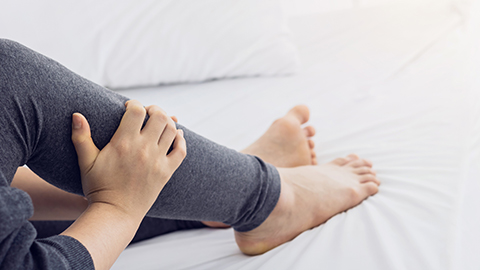06/04/2021

A client comes back to the massage table after a long pandemic-related break. Her therapist notices something new: as the client relaxed, her legs began to twitch and jump, and she felt “tingling” on the top of her foot. What is going on, and can massage therapy help?
Resources:
Garcia-Borreguero, D. et al. “Epidemiology of Restless Legs Syndrome: The Current Status.” Sleep Medicine Reviews 10, no. 3: 153–67. https://doi.org/10.1016/j.smrv.2006.01.001.
Guay, A. et al. “Current Evidence on Diagnostic Criteria, Relevant Outcome Measures, and Efficacy of Nonpharmacologic Therapy in the Management of Restless Legs Syndrome (RLS): A Scoping Review.” Journal of Manipulative and Physiological Therapeutics 43, no. 9: 930–41. https://doi.org/10.1016/j.jmpt.2020.05.004.
Hashemi, S. H., Hajbagheri, A. and Aghajani, M. “The Effect of Massage with Lavender Oil on Restless Leg Syndrome in Hemodialysis Patients: A Randomized Controlled Trial.” Nursing and Midwifery Studies 4, no. 4. https://doi.org/10.17795/nmsjournal29617.
Hu, Shasha et al. “Effectiveness and Safety of Massage in the Treatment of Restless Legs Syndrome.” Medicine 99, no. 48. https://doi.org/10.1097/MD.0000000000023239.
Kambampati, S. et al. “Restless Leg Syndrome in the Setting of Patients With End-Stage Renal Disease on Hemodialysis: A Literature Review.” Cureus 12, no. 8. https://doi.org/10.7759/cureus.9965.
Nasiri, M. et al. “Short-Term Effects of Massage with Olive Oil on the Severity of Uremic Restless Legs Syndrome: A Double-Blind Placebo-Controlled Rria.” Complementary Therapies in Medicine 44: 261–68. https://doi.org/10.1016/j.ctim.2019.05.009.
National Institute of Neurological Disorders and Stroke. “Restless Legs Syndrome Fact Sheet.” Last modified March 17, 2020. www.ninds.nih.gov/Disorders/Patient-Caregiver-Education/Fact-Sheets/Restless-Legs-Syndrome-Fact-Sheet.


This podcast sponsored by:
About Anatomy Trains:
Anatomy Trains is a global leader in online anatomy education and also provides in-classroom certification programs for structural integration in the US, Canada, Australia, Europe, Japan, and China, as well as fresh-tissue cadaver dissection labs and weekend courses. The work of Anatomy Trains originated with founder Tom Myers, who mapped the human body into 13 myofascial meridians in his original book, currently in its fourth edition and translated into 12 languages. The principles of Anatomy Trains are used by osteopaths, physical therapists, bodyworkers, massage therapists, personal trainers, yoga, Pilates, Gyrotonics, and other body-minded manual therapists and movement professionals. Anatomy Trains inspires these practitioners to work with holistic anatomy in treating system-wide patterns to provide improved client outcomes in terms of structure and function.
Website: anatomytrains.com
Email: info@anatomytrains.com
Facebook: facebook.com/AnatomyTrains
Instagram: instagram.com/anatomytrainsofficial
0:00:00.0 Speaker 1: Ruth Werner's best-selling book, A Massage Therapist's Guide to Pathology, is a highly regarded comprehensive resource that sets the standard for pathology education. Written for massage therapy students and practitioners, this ground-breaking resource serves up a comprehensive review of the pathophysiology signs, symptoms, and treatment of more than 500 diseases and disorders. Learn more at booksofdiscovery.com.
0:00:32.2 Speaker 2: Anatomy Trains is happy to announce our return to the dissection lab in-person, January 10 to the 14th, 2022 at the Laboratory of Anatomical Enlightenment in Boulder, Colorado. We are thrilled to be back in the lab with Anatomy Trains author, Tom Myers, and master dissector, Todd Garcia. Join students from around the world and from all types of manual, movement, and fitness professions to explore the real human form, not the images you get from books. This is an exclusive invitation, email info@anatomytrains.com, if you'd like to join us in the lab.
[music]
0:01:16.8 Ruth Werner: Hi, and welcome to I Have A Client Who pathology conversations with Ruth Werner, the podcast where I will discuss your real life stories about clients with conditions that are perplexing or confusing. I'm Ruth Werner, author of A Massage Therapist's Guide to Pathology, and I have spent decades studying, writing about and teaching about where massage therapy intersects with diseases and conditions that might limit our client's health.
0:01:46.1 RW: We almost always have something good to offer even with our most challenged clients, but we need to figure out a way to do that safely, effectively, and within our scope of practice, and sometimes as we have all learned, that is harder than it looks. Today's contributor is a massage therapist in Hudson Valley, New York, who sent me this. "My client is a 53-year-old woman that I've been seeing for three years for relaxation sessions and occasional pain relief. When I resumed practice after my pandemic-related pause, I noticed that while lying supine, her legs began to jump uncontrollably. The twitches became more pronounced. She reported feeling more relaxed with the feeling that something was tingling on the dorsal surface of her foot. She shared that her spouse complained that she would really kick at night with enough force to wake him up. She has not, as of yet, received a formal diagnosis from a doctor, but I was wondering if there was anything I could or would or should be doing with my massage to facilitate relief from her symptoms." Oh, I love questions like this so much.
0:03:00.1 RW: The most likely situation going on here is something called restless leg syndrome, which is also called Willis-Ekbom disease, but restless leg syndrome, or RLS, is a much more descriptive term. So we're gonna stick with that. It's a movement disorder related to some central nervous system issues, and we'll get to that more in a moment. RLS affects, maybe, we think, somewhere between 2% to 15% of the adult population. That's a statistic from the International Restless Leg Syndrome Research Group. Men and women can both have it, but women get it, or at least women report it more often. Some populations are particularly prone to restless leg syndrome, including women in perimenopause. That time leading up to the end of having an obvious menstrual cycle, like say for this 53-year-old client. Other people who are prone to restless leg syndrome are people with fibromyalgia, people who are pregnant, people with diabetes, especially those who use dialysis. The Restless Leg Syndrome Research Group suggests that 20% to 80% of people who use dialysis also report having restless leg syndrome.
0:04:14.5 RW: So what is really happening here? Restless leg syndrome is classified as a movement disorder, and that puts it in the same category as Parkinson's disease, tremor, and dystonia. It is described as a movement disorder, but its main symptom is sensory, an unpleasant feeling that causes an irresistible urge for people to move their legs. Symptoms tend to get worse late in the day and in the evening and are especially noticeable when the person is otherwise still, trying to sleep, for sure, but also doing things like watching a movie, sitting on a plane, and so on.
0:04:54.4 RW: Those unpleasant sensations are described as throbbing, aching, itching, creeping, or crawling. It can be on one or both sides or it can alternate back and forth. The sensations often peak at night time and subside in the morning. Many people report that they sleep best in the morning. It can disrupt sleep only occasionally or seven times a week. Some people with restless leg syndrome go into spontaneous remission, symptoms simply subside or go away, but others have this as a chronic, ongoing challenge that may get worse over time. The most common type of restless leg syndrome is idiopathic. It's unclear what causes it. It appears to run in some families, so clearly a genetic component is a factor for at least some people. It has been correlated with a disruption in the basal ganglia and dopamine pathways in motor centres of the brain, which is why a current treatment option is similar to what is also used for Parkinson's disease, which has a similar pathophysiological pattern.
0:06:05.6 RW: This client hasn't consulted with her doctor about her situation, so we don't know for sure if restless leg syndrome is what's going on for her. If she did see a doctor, her diagnosis would be based on her symptoms rather than on any specific diagnostic or imaging tests.
0:06:22.0 RW: The criteria for restless leg syndrome include these things: A strong and often overwhelming need or urge to move the legs that is often associated with abnormal, unpleasant or uncomfortable sensations, the urge to move the legs starts or gets worse during rest or inactivity, the urge to move the legs is at least temporarily and partially or totally relieved by movement, the urge to move the legs starts or is aggravated in the evening or night time, and the above four features are not due to any other medical or behavioral condition. There aren't a lot of differential diagnoses that might be confused with restless leg syndrome, but there is a specific sleep disorder called periodic limb movement disorder that has a lot of overlap with it. It's easy to write this off as a mildly, annoying, quirky disorder, but it can have a serious impact on a person's quality of life. You can imagine the overlap between restless leg and sleep disorders, and people who don't sleep well are vulnerable to a whole host of secondary problems, and this is why it is important to address it and treat it if possible. The conventional approach to restless leg syndrome treatment is to suggest avoiding caffeine and alcohol because both of these tend to make symptoms worse, to establish healthy sleep habits, to do moderate exercise and stretching for the legs, to use warm baths, and I know you're waiting for it, massage, and we'll get back to that in a minute.
0:08:03.7 RW: Let's talk about other treatment options first though. Interestingly, one contributing factor to restless leg syndrome for some people is iron deficiency. Supplementing iron can be helpful, but that can be tricky for some people, so finding the best way to boost iron levels can be a challenge. But for some people, these non-invasive, non-drug-based interventions are not sufficient and they might need to use medication. A variety of options are available and they all carry some substantial baggage in the form of side effects. Anti-seizure drugs like gabapentin and pregabalin. These are the sorts of drugs used with fibromyalgia, by the way, and there's a lot of crossover among these patients. These are being used more and more often for restless leg syndrome because it looks like they're as effective as some other options with less severe side effects and risks for secondary problems. Still, people using anti-seizure drugs often experience dizziness, fatigue, and sleepiness, which sort of defeats the purpose of trying to control the restless leg syndrome. Dopaminergic drugs are in the same category as Parkinson's disease drugs, and these can work well, but for some people, long-term use actually leads to worsening symptoms, and there's a variety of disturbing side effects that makes them less useful than we had hoped they would be.
0:09:34.2 RW: Benzodiazepines and opioids definitely promote restful sleep, but they also cause excessive daytime sleepiness and reduced energy and poor concentration, they can make sleep apnea worse, and of course, there's that pesky problem of them being habit-forming. Okay, so we have this central nervous system-based movement disorder that involves unpleasant, creepy-crawly sensations in the legs, which compels people to be in movement. It's worse at night when people have to be still. It's treated with exercise, stretching, warm baths, and drugs that suppress nervous system activity. Do we see a role for massage here? Definitely. As we have seen, massage comes up in the list of non-drug interventions for restless leg syndrome, although I expect this refers to patients massaging their own legs when they feel those unpleasant sensations. When we consider possible risks and benefits for massage and what approaches might be most helpful for this client, here are some things to think about. First of all, we don't know for sure if restless leg syndrome is really what this particular client is dealing with, there aren't many other options, but it would be great to know just to rule out anything unexpected, if possible. So for this lady, I would ask her at least to call her primary care provider to see if they wanna evaluate her for restless leg, especially if this is becoming a more severe problem that is interfering with her sleep and quality of life.
0:11:07.5 RW: And for patients who have definitely been diagnosed with restless leg, where does that leave us? The main risks I can imagine in this situation is if the client is using a medication that makes them feel tired or loogie and then massage makes that worse. We may need to accommodate for that by choosing more stimulating strokes to finish the massage, leaving the client extra time to transition back to full speed and making sure they're fully present before they try to drive home. But what kinds of benefits might we be able to provide? That is hard to predict. If this topic has peaked your interest, I have some good news. I found lots of great resources all about restless leg, so our reference list for this episode's show notes is especially rich, and there is, I'm happy to say, a nice array of research projects that support massage for people with restless leg syndrome, and of course, I will include those links. One randomized controlled trial from Iran looked at massage with lavender oil for people undergoing hemodialysis compared to usual care, and they found a significant reduction in symptoms for the experimental group compared to the control group that didn't report any particular changes. Importantly, this study made note that no adverse events occurred even for a medically complicated population, and this is always very useful to see.
0:12:37.0 RW: There's a literature review out of Harvard that found that for patients with end-stage renal disease, another very medically-complex population, home-based massage was safe and effective for symptomatic relief of restless leg. This doesn't address professional massage, but it at least suggests that this type of intervention doesn't carry specific risks or doesn't need to be avoided. In another article, in which I'm sorry, I haven't gone beyond the abstract, compares massage with olive oil, to massage with liquid paraffin to the legs and feet of patients in a dialysis clinic. The olive oil group had better results to reduce the symptoms of restless leg syndrome, and now [chuckle] I am really curious to find out more about this.
0:13:24.8 RW: Here's where we land, restless leg syndrome is probably pretty common, and for some people, it's a serious problem that alters their ability to sleep, and consequently, their whole quality of life. Home-based massage is frequently recommended to deal with symptoms and professional massage has been examined in the context of people on dialysis with positive findings for symptomatic relief and for safety. Patients may be using medication that makes them sleepy, so session plans need to accommodate for that if it's a problem, and massage to the legs and feet is likely to feel great, but whether it will alter the frequency, duration, or severity of restless leg syndrome symptoms for this client, that's still an open question. One thing we can say with some confidence, though, is that massage is probably not gonna make this worse or cause any new problems. We don't have any information on what techniques or approaches appear to be best for people who are not on dialysis who have restless leg.
0:14:26.3 RW: So it's really up to this practitioner and the client to work out together how to proceed. Sorry, contributor, I have no specific guidance for you except you know, maybe don't use liquid paraffin for your lubricant. Gosh, I really have to get more information on that, but what a great project for a case report, right. If this client wants to see if massage can help her restless leg symptoms, or even if massage has some kind of impact on her sleep quality all together, these are things that can be tracked over time, and imagine how useful this kind of data would be to other massage therapists. So with that, listeners, I fully expect to soon be reading your case reports about your clients with restless leg syndrome. Get to work. Hey everybody, thanks for listening to I Have A Client Who pathology conversations with Ruth Werner. Remember, you can send me your I Have A Client Who stories to ihaveaclientwho@abmp.com, that's ihaveaclientwho all one word, all lower case, @abmp.com, I can't wait to see what you send me and I'll see you next time.





